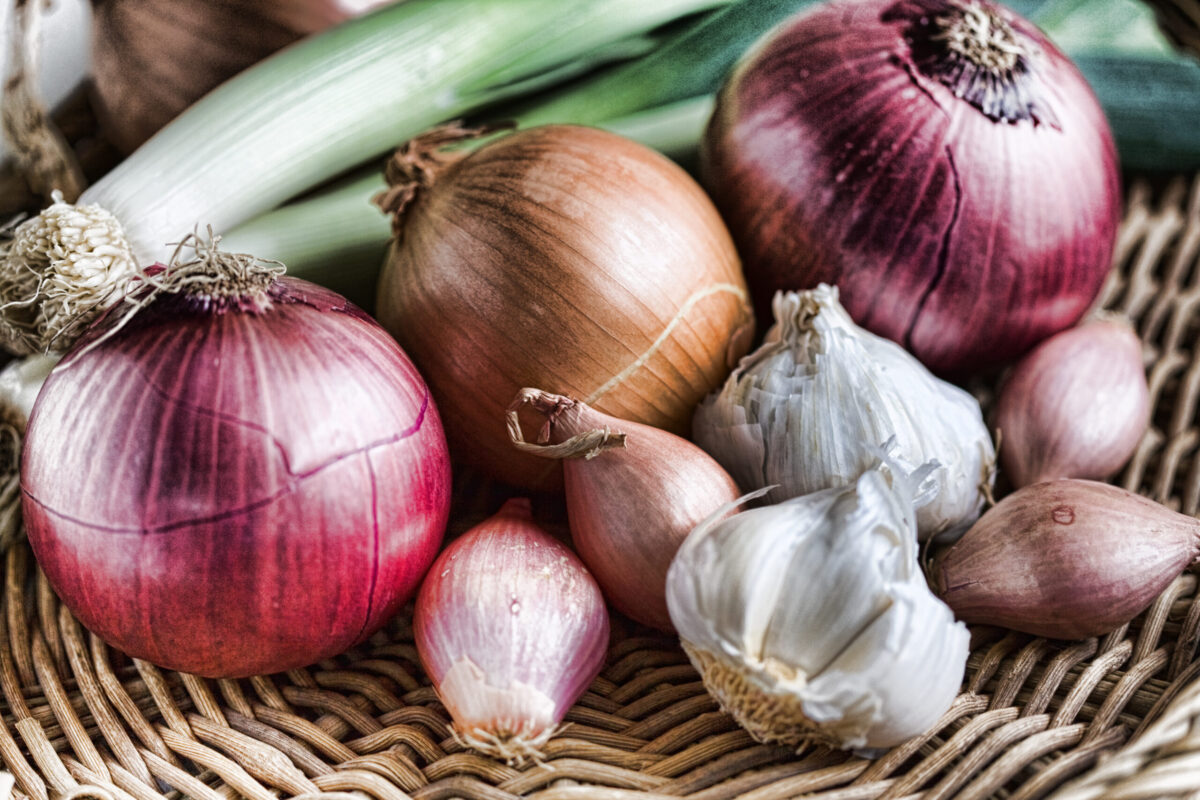You may not be familiar with the term allium, but odds are you are familiar with the plants themselves.
From onions to chives to scallions, here are some common kinds of allium and how to use them at home.
What are alliums?
Alliums are a group of flowering plants that typically have bulbs at the base and long, leafless stalks (scapes) that can produce edible flowers. The scapes of scallions, chives and garlic are all edible.
Common alliums include:
- Onions
- Garlic
- Scallions
- Shallots
- Leeks
- Chives
While all alliums taste like onions or garlic to some degree, each has its own unique flavor and texture. Most alliums are at their peak during spring and summer in Tennessee.
Onions
Onions are the most well-known allium, with hundreds of varieties growing across the world. All are a good source of fiber and folic acid, which helps the body make new cells.
Spring onions
While spring onions look similar to scallions, their small bulbs are mellower, so they’re excellent grilled or roasted whole. The green tops taste like supercharged scallions.
Vidalia onions
These sweet onions originated in the town of Vidalia, Georgia, in the early 1930s. Their sweet taste is a product of having less sulfur in the soil where they grow, and they must be grown in Georgia to be considered Vidalias.
Garlic
Another one of the most common alliums, garlic is high in antibacterial properties, can help lower cholesterol and promotes heart health. A head of garlic typically has 10-15 small sections called cloves.
While there are hundreds of varieties, all garlic is either:
- Hardnecked, with has an extremely firm, woody stalk that sticks up several inches, or
- Softnecked, with parchment over the bulb and flexible stalks. This is the kind of garlic you’ve probably seen in your local market.
Garlic cloves can be roasted whole to bring out their natural sweetness, or they can be smashed, sliced or minced. The smaller you cut your garlic, the more intense its flavor will be. Most garlic will stay good in a cool, dry space for several months.
Green garlic
Also known as young or spring garlic, the “green” in this variety’s name just means that it hasn’t fully matured yet — not that the bulb itself is green. If the bulb is still attached, it will be white with a pink or purple hue, though most green garlic is just sold as stems. Look for green garlic that smells like garlic, not onions, and use it to make a sauce, dressing or compound butter (which is simply butter mixed with at least one other ingredient).
Black garlic
This aged garlic was first used in Asian cuisines, and it must be specially made over several weeks. The cloves are heated, giving the garlic its black color and a syrupy flavor with hints of balsamic vinegar. Black garlic can be found online or in international markets.
Scallions
Also known as spring onions or green onions, scallions are packed with flavonoids, which are powerful antioxidants that have anti-inflammatory properties. You can eat all parts of a scallion except but the very tip of the root, though most recipes call for the green tips. Scallions will typically stay good in your refrigerator for a week or two.
Try scallions:
- Raw, sliced and sprinkled over tofu
- Chopped and added to mashed potatoes
- Sliced and mixed with ginger, oil and vinegar to make a Chinese dipping sauce
Shallots
Shallots are small onions with a mild flavor and a high concentration of protein, fiber, calcium and zinc, which helps the immune system fight off illness. They can range in color from white and yellow to purple or red, and they’ll stay good several months in a cool, dry place.
Try shallots:
- Sliced, pickled and served on sliced meat such as steak or pork
- Finely sliced, fried and sprinkled over grilled shrimp or fish (common in Asian cuisine)
- Grated, mixed with Greek yogurt and served alongside kebabs (common in Persian and Iranian cuisine)
Leeks
Leeks are white and bulbous on one end, with a long cylinder of stiff, green leaves on the other. (Think giant green onions that stand straight up.) Because they are so hardy, they’re relatively easy to grow at home.
Leeks have a mild, onion-like taste with an underlying sweetness, especially when sauteed or roasted. While most recipes use only the white or light-green parts, the leaves can be used to flavor stock. Leeks are high in vitamin A, which boosts the immune and reproductive systems; vitamin K, which strengthens bones; and vitamin B6, which helps your body process protein, carbs and fat.
Try leeks:
- Shaved, raw and tossed in dressing on top of salads
- Braised with carrots, rice, parsley and lemon (common in Turkish cuisine)
- In soups such as leek and potato, vichyssoise (a cold, French, cream-based soup), or cock-a-leekie (a Scottish chicken-and-rice soup made with a peppery broth)
Chives
While you’re probably familiar with the long, thin chives you see in packages at the supermarket, chives actually have edible flowers as well. The green scapes are typically minced and used in sauces or dressings because they have a light peppery, fresh flavor. They also have insect-repelling properties, so they’re ideal to plant in your garden.
Try chives:
- Snipped with scissors over meats before serving
- In egg, tuna or chicken salad
- Mixed into potato dishes and omelettes
To learn more about what’s in season in summer in Tennessee, click here.
Get more information about specific health terms, topics and conditions to better manage your health on bcbst.com. BlueCross BlueShield of Tennessee members can access wellness-related discounts on fitness products, gym memberships, healthy eating and more through Blue365®. BCBST members can also find tools and resources to help improve health and well-being by logging into BlueAccess and going to the Managing Your Health tab.


